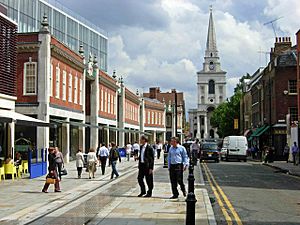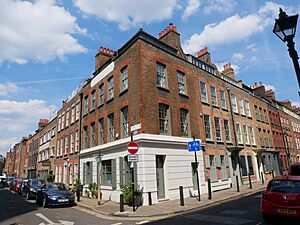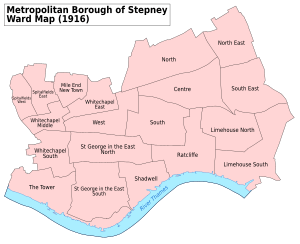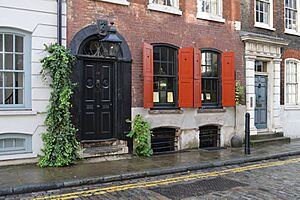Spitalfields facts for kids
Quick facts for kids Spitalfields |
|
|---|---|
 Brushfield Street, looking towards Christ Church and Brick Lane |
|
| Population | 10,286 (2011 Census. Spitalfields and Banglatown Ward) |
| OS grid reference | TQ335815 |
| London borough | |
| Ceremonial county | Greater London |
| Region | |
| Country | England |
| Sovereign state | United Kingdom |
| Post town | LONDON |
| Postcode district | E1 |
| Dialling code | 020 |
| Police | Metropolitan |
| Fire | London |
| Ambulance | London |
| EU Parliament | London |
| UK Parliament | |
| London Assembly | |
Spitalfields (pronounced SPIT-ul-fields) is a lively area in East London, England. It's part of the London Borough of Tower Hamlets. This area is famous for its many markets, including Old Spitalfields Market, Brick Lane Market, and Petticoat Lane Market. For a long time, Spitalfields has welcomed people from all over the world. In the 1800s, many Jewish people moved here, earning it the nickname Little Jerusalem.
Spitalfields used to be a small, independent area called a "Hamlet" within the larger parish of Stepney. It became its own parish in 1729. Being just outside the City of London, it later became part of the County of London in 1889 and then the Metropolitan Borough of Stepney in 1900. In 1965, it became part of the London Borough of Tower Hamlets.
Contents
What's in a Name?
Where the Name Spitalfields Comes From
The name Spitalfields has been around for a long time. In 1399, it was called Spittellond. Later, in 1561, it appeared as The spitel Fyeld and Spyttlefeildes. The name comes from St Mary Spital, which was a priory or hospital built in 1197. A "spital" is an old word for a hospital, which was a place run by a religious group to offer lodging to travelers.
How Spitalfields Was Governed
Before 1086, Spitalfields was part of the large area known as the manor and ancient parish of Stepney.
Originally, parishes mainly handled church matters. But when King Henry VIII closed down monasteries, which used to do a lot of charity work, parishes had to take on new responsibilities. They started helping the poor, which was called the Poor Law.
Stepney was a very big area. By the late 1600s, it divided its civil duties among smaller, independent areas called Hamlets. Spitalfields was one of these Hamlets.
In 1729, Spitalfields became its own independent parish. Its main church was Christ Church, Spitalfields. Another church, St Stephen Spitalfields, was added later but was taken down in 1930.
Over the years, Spitalfields' administration changed several times. It became part of the Metropolitan Borough of Stepney in 1900 and then the London Borough of Tower Hamlets in 1965.
Spitalfields was historically part of Middlesex county. However, many local duties, including military ones, were handled by the Tower Division. This area was loyal to the Tower of London. Men from here served in the Tower garrison instead of the Middlesex Militia. This special arrangement ended in 1889 when Spitalfields became part of the new County of London.
Who Represents Spitalfields?
Most of Spitalfields is part of the Spitalfields & Banglatown ward. This ward elects two councillors to the Tower Hamlets Borough Council. Spitalfields is also in the Bethnal Green and Bow area, which elects a Member of Parliament (MP) to the House of Commons in the UK Parliament. Since 2010, Rushanara Ali from the Labour Party has been the MP for this area.
There's also a group called the Spitalfields Neighbourhood Planning Forum. This group helps local people, businesses, and community organizations have a say in how their neighborhood is planned and developed.
History of Spitalfields
Early Beginnings
For a long time, Spitalfields was mostly open fields and gardens. This changed in the late 1600s when streets were built for Irish and Huguenot silk weavers.
The first signs of human activity here are from a Roman cemetery. This cemetery was found east of the main road, Bishopsgate. In the 1990s, a big archaeological dig happened here. In 2013, scientists studied a tooth from a 25-year-old woman buried in a lead coffin. They found she was from Rome, making her the first known Roman person buried in Britain!

In 1197, the cemetery site became a priory called "The New Hospital of St Mary without Bishopsgate," later known as St Mary Spital. This was one of the largest hospitals in medieval England. It had a big cemetery with a stone building for bones and a chapel. This chapel has been found by archaeologists and can now be seen by the public.
The Priory and Hospital were closed down in 1539 by Henry VIII. Most of the buildings were demolished. However, some parts of the priory area kept their own special administrative status. Other parts were used for an Old Artillery Ground and were under the special control of the Tower of London. By the mid-1600s, more homes were built in the open fields of Spital.
The Huguenots and Silk Weaving
Spitalfields became famous for its silk industry because of French Protestant refugees called Huguenots. They came here after 1685 when they were no longer allowed to practice their religion in France. They settled outside the City of London to avoid strict rules from the City Guilds. The Huguenots brought their amazing weaving skills. Many settled in Spitalfields and nearby areas like Bethnal Green and Shoreditch.
In the late 1600s and 1700s, beautiful terraced houses were built for the master weavers. Grand mansions were also built around Spital Square. Christ Church, Spitalfields, designed by architect Nicholas Hawksmoor, was built to show the power of the Church of England to the Huguenots, who had built many of their own chapels.
There has been a market in Spitalfields since 1638. King Charles I allowed meat, poultry, and vegetables to be sold there. Today, the market attracts about 25,000 visitors every week.
From the 1730s, Irish weavers also came to Spitalfields to work in the silk trade. The silk industry faced tough times, sometimes because of cheaper silk imports from France. This led to protests. In 1769, the Spitalfield riots happened, where weavers protested against low wages.
Victorian Era Changes
By the Victorian era, the silk industry in Spitalfields was declining. The beautiful old merchant houses became crowded slums.
In 1860, a new agreement with France allowed cheaper French silks to be imported. This left many weavers in Spitalfields and nearby areas without work. New jobs like furniture making and boot making came to the area. The large windows in the Huguenot houses were perfect for tailoring, which attracted new Jewish refugees who also worked in the textile industry.
Spitalfields Today
In the late 1900s, the Jewish community became smaller. Many Bangladeshi immigrants moved in, also working in the local textile industry. This made Brick Lane famous as London's "curry capital."
Since the 1960s, there has been a big effort to save the old merchant houses west of Brick Lane from being torn down. Many have been restored by the Spitalfields Historic Buildings Trust. This has made the area more popular and property prices have gone up.
New, modern office buildings have also been built between Bishopsgate and Spitalfields Market. These are like an extension of the City of London. However, people who care about history have managed to save Old Spitalfields Market. It now has shops, fun activities, and a new public space.
Since 1998, Spitalfields has been part of a larger local government area called Spitalfields and Banglatown.
Community Life
Spitalfields has a very strong community spirit. The Spitalfields Community Group works to represent local people and improve their quality of life. Spitalfields Music helps strengthen the community through musical events. The Spitalfields Housing Association also provides good quality services to residents.
There's a special place called Nomadic Community Gardens. It's a temporary community garden built on land that was once overgrown. It's popular with locals who don't have gardens and features street art, sculptures, and allotments.
Culture and Arts
Dennis Severs' House on Folgate Street is a unique place. It's like a "still-life drama" that shows what life might have been like for a family of Huguenot silk weavers. The Society for the Protection of Ancient Buildings has its main office nearby, in a Georgian house once lived in by Huguenots and Russian Jewish leatherworkers.
In 2009, Raven Row, a modern art center, opened on Artillery Lane. It's built in two 18th-century silk merchants' houses. The Whitechapel Art Gallery is also close by, at the end of Brick Lane.
Many famous artists live in Spitalfields, including Gilbert and George, Tracey Emin, and Stuart Brisley. TV presenter and architecture expert Dan Cruickshank has actively worked to protect Spitalfields and still lives there. Writer Jeanette Winterson turned an old Georgian house into an organic food shop called Verde's.
Spitalfields appears in many books, like The People of the Abyss by Jack London and Brick Lane by Monica Ali. The film From Hell, about Jack the Ripper, is also set in 19th-century Spitalfields.
In 2009, a person living in Spitalfields started a blog called Spitalfields Life. Writing as "The Gentle Author," they promised to post 10,000 daily essays about life in Spitalfields and nearby areas.
Economy and Markets
The economy of Spitalfields mainly revolves around its four markets. Old Spitalfields Market is the biggest, selling antiques, food, and fashion. Petticoat Lane Market mostly sells clothes.
Famous People from Spitalfields
Many interesting people have lived or were born in Spitalfields:
- William Allen (1770–1843), a scientist and helper of others.
- Inga Beale (1963–), a British businesswoman who was the first female CEO of Lloyd's of London.
- Dan Cruickshank (1949–), an expert on art and architecture.
- Nicholas Culpeper (1616–1654), a botanist and physician, born here when it was still countryside.
- Tracey Emin (1963–), a famous artist who lives on Fournier Street.
- Gilbert & George (born 1943, 1942), artists who also live on Fournier Street.
- Samuel Gompers (1850–1924), who founded the American Federation of Labor (AFL), was born here.
- Thomas Helwys (around 1575–1616), a religious reformer who started the first Baptist church in Britain here.
- Jack the Ripper: Many of the victims linked to this historical figure lived in Spitalfields.
- Keira Knightley (1985–), a well-known actress, lived on Wilkes Street for a while.
- Joe Loss (1909–1990), a famous bandleader, was born locally.
- George Peabody (1795–1869), who created the Peabody Trust to provide good housing for those in need.
- Jonathan Pryce (1947–), an actor and singer.
- Dennis Severs (1944–1999), who created the unique Dennis Severs' House.
- Jack Sheppard (1702–1724), a famous highwayman, was born here.
- Jeanette Winterson (1959–), a writer who lives and runs a shop on Brushfield Street.
- Mary Wollstonecraft (1759–1797), an early feminist, was born locally.
- Joe Wright (1972–), a film director.
Getting Around Spitalfields
Train and Tube
Spitalfields doesn't have its own London Underground station anymore. It used to have a train station called Bishopsgate (Low Level), which opened in 1872 but closed in 1916. Shoreditch tube station was also nearby but closed in 2006.
However, several stations are very close to Spitalfields:
- Liverpool Street station (mainline trains and Underground)
- Aldgate East (Underground)
- Shoreditch High Street (London Overground)
Roads
The area is built around Commercial Street, which is part of the A1202 London Inner Ring Road.
 |
Shoreditch | Shoreditch | Bethnal Green |  |
| City of London | Whitechapel | |||
| City of London | Whitechapel | Whitechapel |
See also
 In Spanish: Spitalfields para niños
In Spanish: Spitalfields para niños






